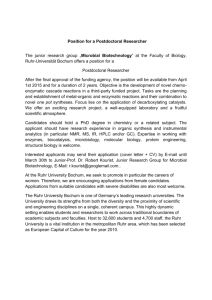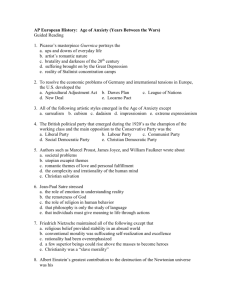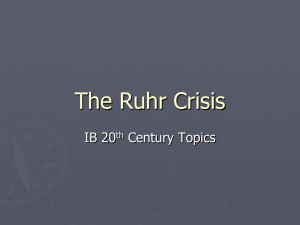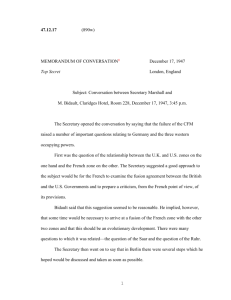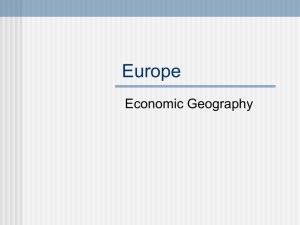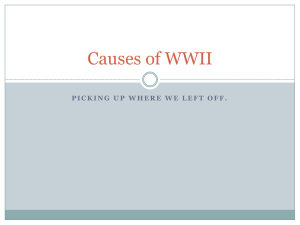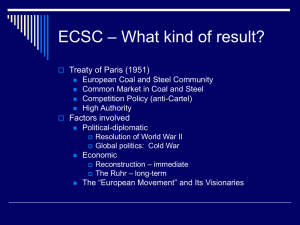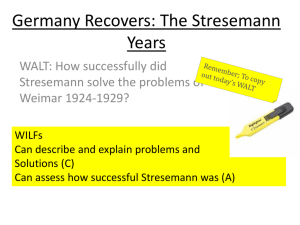Multimedia-Documentation of the Coal Mines in the Ruhr District
advertisement
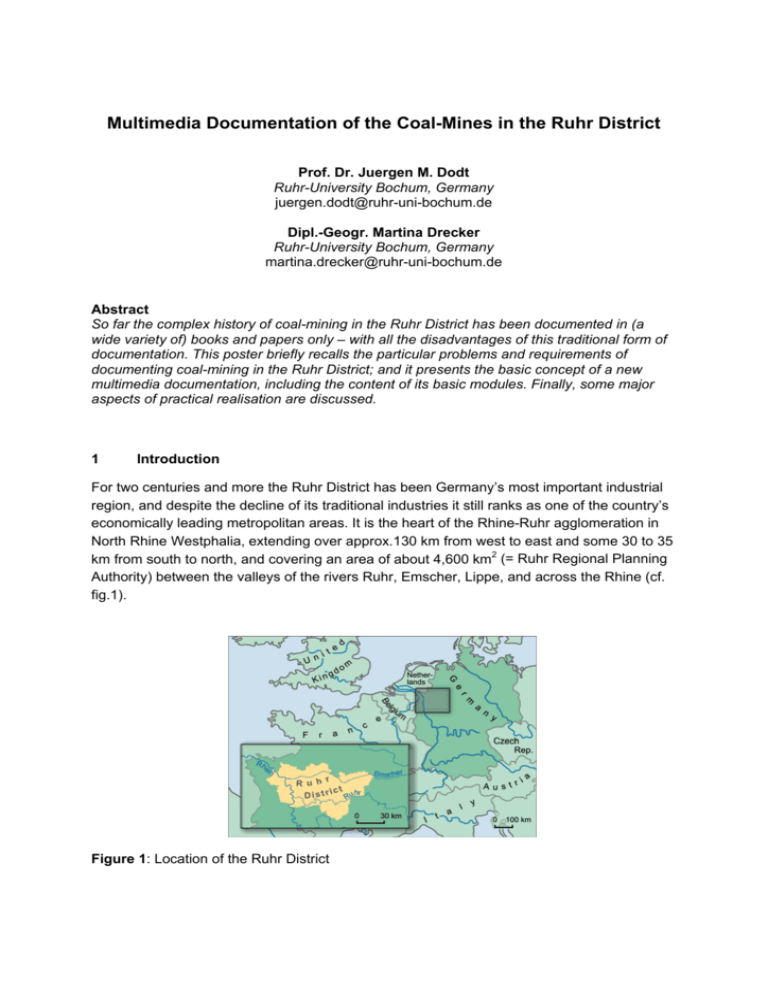
Multimedia Documentation of the Coal-Mines in the Ruhr District Prof. Dr. Juergen M. Dodt Ruhr-University Bochum, Germany juergen.dodt@ruhr-uni-bochum.de Dipl.-Geogr. Martina Drecker Ruhr-University Bochum, Germany martina.drecker@ruhr-uni-bochum.de Abstract So far the complex history of coal-mining in the Ruhr District has been documented in (a wide variety of) books and papers only – with all the disadvantages of this traditional form of documentation. This poster briefly recalls the particular problems and requirements of documenting coal-mining in the Ruhr District; and it presents the basic concept of a new multimedia documentation, including the content of its basic modules. Finally, some major aspects of practical realisation are discussed. 1 Introduction For two centuries and more the Ruhr District has been Germany’s most important industrial region, and despite the decline of its traditional industries it still ranks as one of the country’s economically leading metropolitan areas. It is the heart of the Rhine-Ruhr agglomeration in North Rhine Westphalia, extending over approx.130 km from west to east and some 30 to 35 km from south to north, and covering an area of about 4,600 km2 (= Ruhr Regional Planning Authority) between the valleys of the rivers Ruhr, Emscher, Lippe, and across the Rhine (cf. fig.1). Figure 1: Location of the Ruhr District Figure 2: Generalized geological section through the Ruhr coal-field The economic development and the regional structural differentiation of the Ruhr District have mainly been determined by the particular geological structure of the Ruhr coal-field (cf. fig. 2). The latter is characterised by various groups of coal seams dipping gently northwards from the Ruhr valley, where coalbearing rock is exposed on both valley flanks, beneath the Cretaceous rocks of the Westphalian Bassin, where the coal seams are to be found at depths of more than 1,200 m; different varieties of coal, from semi-anthracitic coal and steam coal (Ruhr valley; for domestic purposes, briquette plants, power stations,) to coking coals (north of the Ruhr valley in the Hellweg zone; for the coke industry), and further northwards gas and long-flame coals (appearing in the Emscher and Lippe zones; for chemical industries). Documented for the first time towards the end of the 13th century, the working of coals was restricted for quite a long time to the zone of the Ruhr valley. It was not until the first half of the 19th century that the first shafts were sunk into the coal seams beneath the Cretaceous cover. In search for coking coal, then gas and long-flame coals for the iron and steel and the chemical industries respectively, the working of coals eventually expanded into the northern zones of the Ruhr coal-field – a process accompanied by various innovations in mining and processing technologies for by-products, causing the decline and eventually the disappearance of „traditional“ adit mines and pits in the south and the rise and existence of larger and larger coal-mines with various plants for by-products in the central and northern belts of the Ruhr District. As a consequence of the long and complex history of coal mining in the Ruhr District, its natural, i.e. geological background and its technological as well as economic and social impact any documentation of the coal-mines has to cope with quite a large number of cases and above all a wide variety of cases, differing with regard to essential characteristics such as history and duration of operation coals worked, mining techniques, production of by-products and – in consequence – complexity of the site, size and structure of buildings and other constructions, number of miners employed etc. Of course, coal-mining and coal-mines in the Ruhr-District have already been dealt with in the past. There are (numerous and various) studies on individual mines, the mines of a particular places or areas, the development of mines within a particular period of time, mining techniques, the relevant constructions of buildings and plants, etc., and there are also comprehensive dictionary-like reference books on the coal-mines of the Ruhr District (BUSCHMANN 1998, HUSKE 1998, HERMANN 1994). Despite, or to be more precise: because of, this rather positive status of research and documentation, it seems worthwhile and useful to produce a new documentation based on multimedia – for the following reasons: (1) Multimedia allows to chose different forms of presenting and communicating information. Apart from texts and graphics it is possible to use sound or video films, and in cartography animated mapping has become a favourite technique to visualize spatial changes. (2) Hypermedia makes it possible to link texts, graphics, and images by hyperlinks – thus giving the users the opportunity to select information according to their own wishes or needs. The existing links draw their attention to connections and interrelations, and they lead the users to all relevant parts of the documentation. (3) The memory capacity of the CD-ROM by far exceeds the „storage capacity“ of an „average“ book, and it does not matter whether coloured images and graphics are included or not (and if so: how many); in addition, all other media may also be stored on the CD-ROM – thus making the CD-ROM a highly versatile and efficient means of publication. Following GAUS (1995) the overall aim of a documentation is to collect relevant documents and information on a given subject, also a region, and to structure and present all this information in such a way that it can easily be retrieved. Considering the advantages of multimedia just summarised it is evident that any documentation of a complex subject with a large amount of information and with intricate spatial interrelations will greatly benefit from applying multimedia techniques. 2 Documentation of Ruhr coal-mines basic structure and main components Because of its long historical tradition, its technological achievements, its outstanding economic importance, its tremendous geographical impact and some other reasons coalmining in the Ruhr District has always been of interest to many people – experts from various subjects and professions as well as the local and regional public (of all age-groups) or tourists (meanwhile visiting the region in rapidly increasing numbers). Therefore, a documentation of the coal-mines will have to consider a rather wide spectrum of users; it should take into account differences of knowledge and it should meet different interests. In order to enable the users a flexible, individual access to the information compiled the documentation comprises four modules accessible via the main opening menue (cf. fig. 3). Figure 3: Main – introductory – menu of the documentation; buttons to get to the four “basic” modules (explanation: cf. text) 2.1 Module 1: Mining in the Ruhr District – an introduction The introductory module is divided into a number of sub-modules. One of them deals with the specific geological characteristics of the Ruhr coal-field and their importance for the development of mining, i.e. in particular its spatial expansion from S to N. Another submodule outlines the technical development of coal-mining, as the working of coals gradually moved from the Ruhr valley and the Hellweg zone to the Emscher and Lippe zones – a process with increasing requirements for, and continuous innovations in, the techniques of mining – from adit mines to shaft mines of increasing depths; thus, the sub-module presents different types of collieries with their changing layout, their different technical installations and buildings. Closely related to that sub-module is another „technical“ sub-module dealing with coal processing in the different zones of the Ruhr District; here, special emphasis is on the development of coke-oven plants and of plants for coke by-products. Additional introductory sub-modules inform about demographic and social aspects, i.e. the miners and their regional origins, the development of housing and housing estates, socials structures, typical traditions and pastimes, etc. 2.2 Module 2: Regional structures and spatial development in thematic maps This module is considered to be an major component of the multimedia documentation. As pointed out above, there is a large number of publications on coal-mining and the coal-mines in the Ruhr District. Nevertheless, only very few aspects have so far been presented and visualised systematically and comprehensively in thematic maps. This applies in particular to the aspect of change in time and space., which is so highly characteristic of coal-mining in the Ruhr District and its regional consequences. Therefore, this module is conceived as a sort of cartographic information system: The user can retrieve all information included in the system. It is also possible for him or her to combine the contents of different maps (as far as this makes sense ([cf. fig. 4]), but – unlike using a GIS – the user cannot create maps of his own. Thus, according to BORCHERT (1999) the module is a „closed multimedia atlas“ while ORMELING (1993) would call it an „interactive electronic atlas“. The range of subjects covered by the „atlas-module“ has to be defined, i.e. limited on the basis of rather pragmatic considerations. In consequence, the module concentrates on basic characteristics illustrating essential spatial as well as structural patterns and developments of coal-mining in the Ruhr District such as spatial distribution of collieries at different times, attributes of collieries such as mining depths and other technical characteristics, output per coal-mine at different times (annual total, percentages of the various coal categories), number of miners employed at different times, miners according to their geographical/ethnic origins, age structure, owners and proprietors at different times, the Ruhr District and other coal-mining areas in Europe, etc. All the individual maps on a particular subject and covering one particular period of time can be combined in multitemporal sequences as animated maps – thus illustrating centres of mining and/or specific regional structures at a given time. Without doubt, one of the most „basic“ maps (or map series) of the atlas-module is that which shows the spatial distribution of coal-mines in different phases of development (cf. also fig. 4). In its animated version this map series illustrates the spatial expansion of coal mining in the Ruhr District from south to north, but also towards WSW and ESE. Simultaneously, these rather simple „distributional maps“ give access to the third module of the documentation: Whenever the users click the signature of a particular colliery on one of the maps they will get to the multimedia documentation of the corresponding mine. Figure 4: Northwards expansion of coal-mining at the Ruhr. The map shows the regional distribution of mines around 1860, and it has been combined with a map depicting the regionalnetworks of railways until 1866. For a better orientation the map also contains the current administrative borders. 2.3 Module 3: dossiers of individual collieries Module 3 is the core of the documentation. Apart from the access just described, i.e. via the maps depicting the spatial distribution of the collieries at a particular time, all relevant information on a specific coal mine can be retrieved via a list of names, i.e. by selecting the name of the colliery on the list, or by entering the name of the coal mine in a search window. The basic introductory page of each colliery always comprises an illustration (in most cases a historical photograph showing typical buildings and installations) and a brief text highlighting typical, i.e. representative features and special characteristics of that particular mine and its development (cf. fig. 5). Then, more specific and more detailed information is accessible via the familiar card index which includes the following categories: geology of the mining field, buildings and technical installations, mining techniques and production of by-products, output of coal (totals, percentages of different coal types) and output of by-products, history of the mine, number of miners employed, surroundings of the mine including miners‘ housing, transport and traffic facilities, published and unpublished sources. The explanatory texts are illustrated as far as possible by photos, parts of maps, drawings, diagrams, etc. and they are as short as possible, i.e. as a rule not exceeding one (screen)page per category; similarly, statistics are confined to „essential“ data quantifying typical trends or changes of trends. If the user wants more detailed statistical and other information he/she should click the button „details“.(cf. for instance in fig. 6) which leads to another user interface (Acrobat Reader) and here to much more detailed information and data on any of the categories listed above. Figure 5: Opening page of module 3. Apart from a brief introductory description of the mine and some representative illustration there is the card box index giving access to further information an the topic printed on the card box. Figure 6: Example of a record card – on the geology of the coal-field – accessible via the card box index; for access to further information the button “details” has to be clicked. 2.4 Module 4: Index of specialist terms Mining and coal-mining in particular has given rise to a special terminology including not only a wide variety of technical terms but also many „insider“ expressions for things of every day life. A documentation claiming authenticity will (have to) make use of this special terminology, and this implies that the terms used must be explained. In consequence, the last module of this documentation includes – as a „service“ to its users – an alphabetical list explaining technical terms and other expressions related to coal-mining in the Ruhr District and used in this documentation. Users interested in the meaning of a particular term refer to the list. If terms are considered to be important, i.e. if they are used more often, they are marked as links; thus, the explanation is accessible to the user directly and without detour via the index. 3 On the practical realisation of the documentation Considering the spatial dimensions of the Ruhr District, the long tradition of coal mining, and the complex spatial structures of the mining industry it hardly needs further explanation that a comprehensive documentation of coal-mines can only be realised gradually, i.e. in successive phases and progressing regionally. In order to recognise potential difficulties and problems to be faced in the realisation of the documentation (and to solve them) as early as possible it seemed advisable and most effective to begin the documentation project with an example as representative as possible. After careful consideration it was decided to concentrate the documentation in its initial phase on the city of Essen. Essen, the biggest city of the region, is situated almost in the centre of the Ruhr District and extends from the Ruhr valley in the south, i.e. from the exposed coal-bearing rocks, via the Hellweg to the Emscher zone, i.e. to the concealed coalfield in the north. Coal-mining has been verified for centuries, and there were more than 800 active mines – among them „Zeche Zollverein“, the biggest coal mine in Europe so far. In other words: Essen is quite representative with regard to the geological setting and structures, the historical and technical development, the spectrum of mines, ranging from the early „pit bells“ and small adit mines to combined deep shaft mine units, the effects of mining on the economic, social structures, housing conditions etc. In addition, Essen can also be considered as representative with regard to the conditions of collecting relevant data and information: There is no central archive; so the search for appropriate material had to extend over various places including private collections of amateur historians. Furthermore, source material available turned out to be incomplete and/or inconsistent, and very often the question of copyright was quite difficult to solve. To realise the multimedia applications of the documentation, i.e. the introductory pages (including explanations on how to use the documentation) as well as all the pages of the modules, the software Macromedia Director 8.0 and its programming language Lingo have been used. As mentioned above, all additional data and information are accessible through the programme Adobe Acrobat. The graphic design is the result of a pragmatic compromise: On the one hand, it tries – of course – to be as interesting and attractive as possible for a wide public. Therefore, much attention is given to the application of animated mapping techniques, the integration of film/video sequences and sound documents. On the other hand, the design should be simple enough not to distract the user from directly grasping the information, and it should also be straightforward enough to be practically realised without wasting too much time and money. References: BORCHERT, Axel (1999): Multimedia Atlas Concepts. William CARTWRIGHT, Michael P. PETERSON, Georg GARTNER (Eds.): Multimedia Cartography. Berlin, pp. 75-86 BUSCHMANN, Walter (1998): Zechen und Kokereien im rheinischen Steinkohlenbergbau. Aachener Revier und westliches Ruhrgebiet. Berlin GAUS, Wilhelm (1995): Dokumentations- und Ordnungslehre. Theorie und Praxis des Information Retrieval. Berlin HERMANN, Wilhelm und Gertrude (1994): Die alten Zechen an der Ruhr. Königstein, 4. Auflage HUSKE, Joachim (1998): Die Steinkohlenzechen im Ruhrrevier. Daten und Fakten von den Anfängen bis 1997. Bochum, 2. Auflage ORMELING, Ferjan (1993): Ariadne’s thread – Structure in multimedia atlases. Proceedings of the 16th International Cartographic Conference, Cologne, pp. 1093-1100
